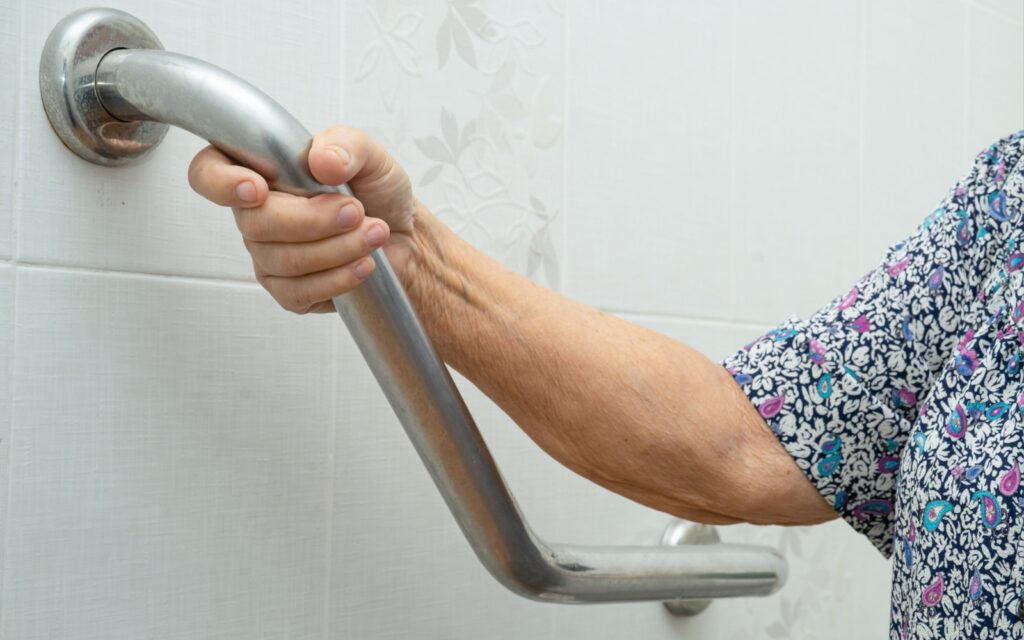Falls are one of the leading causes of injury for seniors, and many falls can be prevented with the proper safety measures in place. Removing tripping hazards, installing handrails, and physical activity are just a few ways to help your loved one stay safe in their home.
Whether your parent lives independently or in a senior living community, taking proactive steps towards safety can significantly reduce the likelihood of accidents. By incorporating some simple changes into daily routines and environments, you can empower yourself to help ensure the safety of your loved ones.
Safety Measure #1: Remove Tripping Hazards
One of the easiest and most effective ways to prevent falls is by keeping living spaces free of tripping hazards. Items like loose rugs, cords, and clutter in walkways can quickly become dangerous, especially for seniors with limited mobility or vision issues. Ensuring that all frequently used areas, like hallways and living rooms, are clear of clutter can significantly reduce the risk of accidents.
Consider adding non-slip mats in the bathroom and kitchen, as these areas are prone to spills and moisture. Arrange furniture to allow easy movement through the home and eliminate any obstacles. Simple adjustments can make their home a much safer place.
Safety Measure #2: Improve Lighting Throughout the Home
Good lighting is crucial for preventing falls, especially for seniors with declining vision. Poor lighting can make it difficult to see obstacles, uneven surfaces, or changes in floor level, leading to trips and falls. To enhance safety, ensure every room, hallway, and stairwell is well-lit, especially at night.
Consider adding nightlights in bedrooms, bathrooms, and hallways to help seniors navigate during nighttime trips. Motion-sensor lights can also be beneficial, automatically turning on when movement is detected. Ensuring light switches are easily accessible and located near entrances can further increase safety and independence.
Safety Measure #3: Install Grab Bars and Handrails
Bathrooms and staircases are common areas where falls can occur, especially if there is nothing sturdy to hold onto. Installing grab bars in the shower, beside the toilet, and along hallways can provide extra support and stability. Similarly, having secure handrails on both sides of stairways is essential for balance when climbing or descending stairs.
When installing grab bars and handrails, ensure they are securely anchored to the wall and made of non-slip material. These additions can significantly reduce the chances of someone losing their balance and falling. This is especially true for seniors, who are frail or have mobility issues.
Safety Measure #4: Encourage Proper Footwear
Wearing appropriate footwear can help seniors maintain their balance and avoid falls. Shoes with good support, non-slip soles, and a proper fit are essential for reducing the risk of accidents. Slippers and socks, while comfortable, can often lead to slipping, especially on hardwood or tile floors.
Encourage your loved ones to avoid wearing flip-flops or high heels and opt for shoes with rubber soles instead. If your senior parent has trouble putting on or taking off shoes, consider adaptive footwear that is easy to slip on but still secure. Proper footwear is a simple but impactful step toward fall prevention.
Safety Measure #5: Promote Physical Activity
Keeping physically active can improve strength, balance, and coordination, which are all crucial for fall prevention. Encourage your senior parent to engage in exercises focusing on flexibility, strength training, and balance, such as walking, swimming, or yoga. Even low-impact exercises can make a big difference in maintaining mobility and reducing the likelihood of falls.
Many senior living communities offer fitness programs tailored to older adults, which can be a great way to stay active and social. Before starting any new exercise routine, seniors should consult their doctor to ensure the activities are appropriate for their health condition.
How Falls Affect Seniors
Falls can profoundly impact a senior’s health, both physically and emotionally. One of the most immediate concerns following a fall is the potential for serious injury, such as broken bones, head trauma, or hip fractures. These injuries often require hospitalization and long-term rehabilitation, which can limit a senior’s independence and mobility for extended periods.
In addition to physical injuries, falls can lead to a significant loss of confidence. After experiencing a fall, many seniors become fearful of falling again, which may cause them to limit their activities or even avoid leaving the house. This decline in activity can lead to isolation, depression, and a further reduction in physical fitness, creating a vicious cycle that increases the risk of future falls.
For seniors with chronic health conditions such as osteoporosis or arthritis, falls can exacerbate their symptoms, making recovery even more challenging. These conditions weaken bones and joints, increasing the likelihood of fractures or sprains resulting from minor falls. In some cases, seniors may never fully recover their previous level of mobility or independence, leading to a need for additional care or assistance.
Risk Factors for Falling as a Senior
Seniors with the following risk factors are at a higher risk of falling and potentially hurting themselves:
- Balance or walking difficulties: Loss of muscle strength may prevent older adults from maintaining or recovering balance when stepping on uneven surfaces or being bumped.
- Reduced Vision: With aging, people become less able to judge where objects are in relation to each other and may need brighter light to see well.
- Reduced sensation, particularly in the feet: Reduced sensation can make it harder for seniors to feel the ground beneath them, increasing the risk of falls.
- Loss of muscle strength: Loss of muscle strength can compromise balance and stability, making falls more likely.
- Declining cognition: Cognitive impairment may prevent older adults from remembering to take safety measures, such as holding onto a railing when using stairs.
- Low blood pressure or slow heartbeat: Low blood pressure or a slow heartbeat can cause dizziness, fainting, or loss of consciousness, as heart problems reduce the blood supply to the brain.
- Medication use: Certain medications that affect attention (e.g., opioid analgesics, anti-anxiety medications, and some antidepressants) or lower blood pressure (e.g., antihypertensives, diuretics, and some heart medications) can increase the risk of falling.
Discover Assisted Living at Meadow View Senior Living
At Meadow View Senior Living, we prioritize safety and well-being, offering a supportive environment where seniors can live fully and enjoy peace of mind. Our team is dedicated to providing personalized care and assistance to help prevent falls and ensure a safe, comfortable lifestyle.
Schedule a tour today to learn more about how we can support your loved one’s journey to a secure and fulfilling future.



